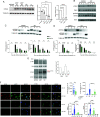IFI207, a young and fast-evolving protein, controls retroviral replication via the STING pathway
- PMID: 38860764
- PMCID: PMC11253629
- DOI: 10.1128/mbio.01209-24
IFI207, a young and fast-evolving protein, controls retroviral replication via the STING pathway
Abstract
Mammalian AIM-2-like receptor (ALR) proteins bind nucleic acids and initiate production of type I interferons or inflammasome assembly, thereby contributing to host innate immunity. In mice, the Alr locus is highly polymorphic at the sequence and copy number level, and we show here that it is one of the most dynamic regions of the genome. One rapidly evolving gene within this region, Ifi207, was introduced to the Mus genome by gene conversion or an unequal recombination event a few million years ago. Ifi207 has a large, distinctive repeat region that differs in sequence and length among Mus species and even closely related inbred Mus musculus strains. We show that IFI207 controls murine leukemia virus (MLV) infection in vivo and that it plays a role in the STING-mediated response to cGAMP, dsDNA, DMXXA, and MLV. IFI207 binds to STING, and inclusion of its repeat region appears to stabilize STING protein. The Alr locus and Ifi207 provide a clear example of the evolutionary innovation of gene function, possibly as a result of host-pathogen co-evolution.IMPORTANCEThe Red Queen hypothesis predicts that the arms race between pathogens and the host may accelerate evolution of both sides, and therefore causes higher diversity in virulence factors and immune-related proteins, respectively . The Alr gene family in mice has undergone rapid evolution in the last few million years and includes the creation of two novel members, MndaL and Ifi207. Ifi207, in particular, became highly divergent, with significant genetic changes between highly related inbred mice. IFI207 protein acts in the STING pathway and contributes to anti-retroviral resistance via a novel mechanism. The data show that under the pressure of host-pathogen coevolution in a dynamic locus, gene conversion and recombination between gene family members creates new genes with novel and essential functions that play diverse roles in biological processes.
Keywords: AIM-2-like receptor; evolution of gene function; nucleic acid sensor; viral immunity.
Conflict of interest statement
The authors declare no conflict of interest.
Figures




References
MeSH terms
Substances
Grants and funding
LinkOut - more resources
Full Text Sources
Molecular Biology Databases
Research Materials
Miscellaneous
